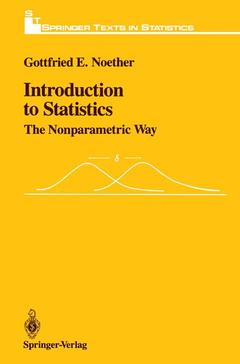Introduction to Statistics, 1991 The Nonparametric Way Springer Texts in Statistics Series
Langue : Anglais
Auteur : Noether Gottfried E.

The introductory statistics course presents serious pedagogical problems to the instructor. For the great majority of students, the course represents the only formal contact with statistical thinking that he or she will have in college. Students come from many different fields of study, and a large number suffer from math anxiety. Thus, an instructor who is willing to settle for some limited objectives will have a much better chance of success than an instructor who aims for a broad exposure to statistics. Many statisticians agree that the primary objective of the introductory statistics course is to introduce students to variability and uncertainty and how to cope with them when drawing inferences from observed data. Addi tionally, the introductory COurse should enable students to handle a limited number of useful statistical techniques. The present text, which is the successor to the author's Introduction to Statistics: A Nonparametric Approach (Houghton Mifflin Company, Boston, 1976), tries to meet these objectives by introducing the student to the ba sic ideas of estimation and hypothesis testing early in the course after a rather brief introduction to data organization and some simple ideas about probability. Estimation and hypothesis testing are discussed in terms of the two-sample problem, which is both conceptually simpler and more realistic than the one-sample problem that customarily serves as the basis for the discussion of statistical inference.
1 Introduction: Why Study Statistics?.- 1.1 Minitab Appendix.- 2 Organizing and Summarizing Data.- 2.1 Stem-and-Leaf Diagrams.- 2.2 Histograms.- 2.3 Five-Number Summaries.- 2.4 Boxplots.- 2.5 Minitab Appendix.- Problem Set for Chapter 2.- 3 Intuitive Inference.- 3.1 Opinion Polls.- 3.2 Capture-Recapture.- 3.3 The Taxi Number Problem.- 3.4 Hypothesis Testing.- 3.5 Categorical and Measurement Data.- 3.6 Minitab Appendix.- Problem Set for Chapter 3.- 4 Probability.- 4.1 The Frequency Interpretation of Probability.- 4.2 Random Numbers.- 4.3 Independence.- 4.4 The Taxi Number Problem Revisited.- 4.5 Minitab Appendix.- Problem Set for Chapter 4.- 5 The Normal Distribution.- 5.1 Distributions as Probability Models.- 5.2 Areas Under the Normal Curve.- 5.3 Minitab Appendix.- Problem Set for Chapter 5.- 6 Hypothesis Testing.- 6.1 The Two-Sample Problem.- 6.2P-Values.- 6.3 Tests of Significance.- 6.4 Making Decisions.- Problem Set for Chapter 6.- 7 The Wilcoxon Two-Sample Test.- 7.1 Test Statistics for the Wilcoxon Two-Sample Test.- 7.2 The Rank Form of the Wilcoxon Two-Sample Test.- 7.3 The Wilcoxon Two-Sample Test with Tied Observations.- 7.4 Minitab Appendix.- Problem Set for Chapter 7.- 8 Nonparametric and Parametric Tests.- 8.1 The Two-Samplet-Test.- 8.2 Wilcoxon Versust-Tests.- 8.3 Minitab Appendix.- Problem Set for Chapter 8.- 9 Estimation: The Two-Sample Shift Model.- 9.1 Elementary Estimates for?.- 9.2 Point Estimates for the Shift Parameter?.- 9.3 Confidence Intervals for the Parameter?.- 9.4t-Intervals.- 9.5 Choosing an Estimate.- 9.6 Minitab Appendix.- Problem Set for Chapter 9.- 10 Point Estimates, Confidence Intervals, and Tests of Hypotheses.- 10.1 The Wilcoxon Two-Sample Test and theId-Interval.- 10.2 Elementary Estimates.- 10.3 Minitab Appendix.- Problem Set for Chapter 10.- 11 The One-Sample Problem.- 11.1 General Populations: Sign-Test Procedures.- 11.2 Symmetric Populations: Wilcoxon Procedures.- 11.3 Normal Populations:t-Tests andt-Intervals.- 11.4 MinitabAppendix.- Problem Set for Chapter 11.- 12 The Two-Sample Problem: Paired Observations.- 12.1 Lotion Y Versus LotionX.- 12.2 The Analysis of Paired Observations.- 12.3 Designing a Paired Observation Experiment.- 12.4 Estimation in Paired Observation Experiments.- 12.5 Minitab Appendix.- Problem Set for Chapter 12.- 13 The Analysis of Bivariate Data.- 13.1 Fitting a Line to a Scatter Diagram.- 13.2 Testing for Independence.- 13.3 Rank Correlation.- 13.4 Minitab Appendix.- Problem Set for Chapter 13.- 14 Least Squares Regression and Correlation.- 14.1 The Principle of Least Squares.- 14.2 The Index of Determination.- 14.3 The Correlation Coefficientr.- 14.4 A Test of Independence.- 14.5 General Regression Models.- 14.6 Minitab Appendix.- Problem Set for Chapter 14.- 15 Comparative Experiments: k-Samples.- 15.1 The Kruskal—Wallis Test.- 15.2 The Friedman Test.- 15.3 Paired Comparisons.- 15.4 Minitab Appendix.- Problem Set for Chapter 15.- 16 Analysis of Variance.- 16.1 The F-Test for theEquality of k Means.- 16.2*Analysis of Variance.- 16.3 Minitab Appendix.- Problem Set for Chapter 16.- 17 The Analysis of Categorical Data.- 17.1 The Chi-Square Statistic.- 17.2 Examples.- 17.3 Minitab Appendix.- Problem Set for Chapter 17.- 18 Chi-Square Tests for Two-Way Classifications.- 18.1 Tests of Association.- 18.2 2 x 2 Tables.- 18.3*Tests of Homogeneity and Tests of Independence.- 18.4 Minitab Appendix.- Problem Set for Chapter 18.- 19 Binomial Probabilities.- 19.1 Binomial Experiments.- 19.2 Binomial Probabilities.- 19.3 Minitab Appendix.- Problem Set for Chapter 19.- 20 The Analysis of Binomial Experiments.- 20.1 Point Estimates forp.- 20.2 Confidence Intervals forp.- 20.3 Tests of Hypotheses Aboutp.- Problem Set for Chapter 20.- Tables.
Request lecturer material: sn.pub/lecturer-material
Date de parution : 09-2012
Ouvrage de 415 p.
15.5x23.5 cm
Disponible chez l'éditeur (délai d'approvisionnement : 15 jours).
Prix indicatif 52,74 €
Ajouter au panierThème d’Introduction to Statistics :
Mots-clés :
Boxplot; Fitting; Minitab; Normal distribution; Variance; analysis of variance; best fit; classification; correlation; linear regression; statistics
© 2024 LAVOISIER S.A.S.



